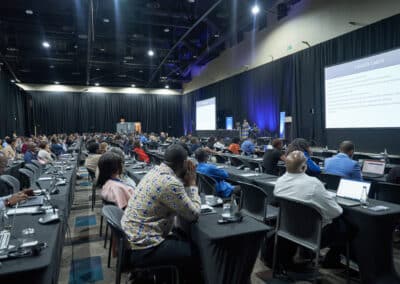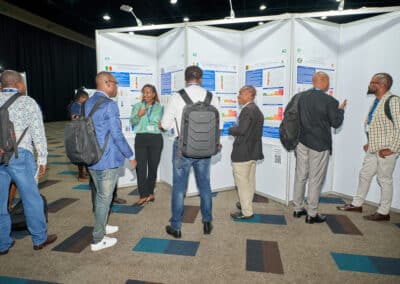The University of Zimbabwe Professor of Medicine has been working on combating HIV/AIDS for decades. We caught up with Dr. Hakim at the CQUIN workshop for patients at high risk of advanced HIV disease progression to ask him about the REALITY trial, a study on advanced treatment for HIV patients in four countries that he and his colleagues worked on together. It is a testament to how far the fight against HIV has come.
“When I practiced in Zimbabwe in the early 90s, the medical and pediatric wards were full with HIV patients, and it was nearly impossible to do anything meaningful due to all of the opportunistic infections they had,” said Dr. Hakim. “But today, we’re talking about differentiated care and how to treat different groups of patients with varying treatment. This is history.”
Tell us about yourself.
I am a physician and HIV researcher. My colleagues and I at the University of Zimbabwe carry out a lot of collaborative research. We work with networks in the United States such as the Adult Clinical Trials Network (ACTN), HIV Prevention Trials Network (HPTN), and others. We also have active collaboration with European groups, especially the Medical Research Council of the United Kingdom and the Europe-Developing Countries Clinical Trials Partnership (EDCTP) – the collective that conducts clinical trials in sub-Saharan Africa.”
Tell us about the REALITY trial and its outcomes.
REALITY stands for Reduction of Early Mortality in HIV-Infected Adults and Children Starting Antiretroviral Therapy. For the study, we enrolled 1,805 patients in Uganda, Kenya, Malawi, and Zimbabwe. The participants were divided into two groups: those that got what is considered the “standard of care” prophylaxis, consisting of Cotrimoxazole daily, plus antiretroviral therapy (ART), and another that received what we call “enhanced prophylaxis”.
We followed these two groups of patients for 48 weeks. First, we looked at the risk of mortality at six months. What we found is that those who were getting enhanced prophylaxis had a much lower risk of mortality – 8.9 percent comparted to 12.2 percent. A year in, we still saw a marked difference between the two groups – a death rate of 11 percent in the enhanced prophylaxis group, and 14.4 percent in the other.
What is “enhanced prophylaxis”?
When we initiate patients on ART, the goal is to make them better and to reduce the risk of mortality. Recently we have observed that patients initiating ART in sub-Saharan Africa continued to have high death rates and remained sick at a much higher rate than similar individuals in developed countries. In fact, patients in developing countries were two to three times more likely to die or remain sick than those in the Western countries in the first six months to one year of initiating ART. We wanted to know why.
We observed that patients in sub-Saharan Africa presented for treatment at a much sicker stage with low CD4 count, but they also tend to have numerous co-morbid conditions, many of which are infections, such as tuberculosis (TB), cryptococcal disease, bacterial sepsis, and worms. These patients also tended be less well, nutritionally. We were grappling with how to address these issues.
We thought, in addition to starting patients on ordinary treatment with antiretrovirals; why not intensify the treatment by adding some drugs that tend to attack the virus much faster? The study had three arms. The first arm was just giving the regular round of antiretroviral drugs, and adding Raltegravir, a drug that can reduce the virus very fast. The second arm was giving participants additional nutrition, irrespective of if they appeared nutritionally compromised. For these first two arms, the results were clear: there was no difference in treatment outcomes whether you added Raltegravir or provided additional nutrition.
Now for the exciting part. For the third arm of the study, we gave participants what we call enhanced prophylaxis: a package of drugs to prevent the occurrence of certain diseases. One of the drugs in the prophylaxis package, Cotrimoxazole, is widely used and found in every country’s treatment guidelines. Cotrimoxazole must be given to everyone starting antiretroviral drugs.
The second drug, Isoniazid, was given to patients to reduce the risk of contracting TB. It is always important to exclude active TB when evaluating patients for ART, because it is one of the most common conditions that goes along with HIV infection. HIV patients who do not have active TB can be given Isoniazid, which can reduce the risk of TB and save lives.
The third drug, Fluconazole, can reduce the chances that patients contract cryptococcol disease. Patients who are very sick and have a very low CD4 count have a very high risk of contracting this fungal infection, especially cryptococcal meningitis, which is a devastating disease.
As I mentioned earlier, many bacteria can cause infections, or sepsis. The fourth drug we provided to patients in the trial was the antibiotic Azithromycin, which prevents sepsis. All of these drugs combined are what we call enhanced prophylaxis, or the enhanced package of care.
What was new about the package you were offering to participants?
Cotrimoxazole is already a standard of care and Isoniazid is a drug that has been approved by the World Health Organization (WHO), accepted by many countries, and promoted by lots of organizations, but unfortunately the uptake has been extremely weak – only 25 percent of patients initiating ART are also put on Isoniazid to prevent TB.
Fluconazole is another intervention accepted by WHO and other countries but it is less widespread than other interventions I mentioned, so it’s worth emphasizing this should happen in a much more widespread manner. Azithromycin for sepsis is something that is generally not given as prophylaxis. Patients who present with a low CD4 count without additional infection are usually not given this intervention.
We are really ensuring that the entire range of prophylaxis interventions are implemented at the commencement of ART. One should think of all of these interventions together instead of thinking of them singularly.
How does REALITY relate to differentiated service delivery?
We have shared these results with the WHO, and they have been published in peer-reviewed journals. As countries move toward differentiated service delivery and other models to address antiretroviral programs, it’s important to take our findings in consideration. All of the patients we studied in the trial had advanced disease, with CD4 counts less than 100, so this is a group that needs to be handled differently from those we consider extremely stable and who can be seen at very prolonged intervals, up to six months and so on.
So these patients need to be cared for in health facilities that are able to provide this range of prophylaxis and they will need to be seen relatively frequently by people who are trained to ensure these interventions are provided and any adverse effects are taken care of. It is going to add a layer of additional work but it will clearly improve outcomes and is an essential part of differentiated service delivery.
What were the key takeaways from the trial?
It is possible, through careful and thoughtful analysis of what the drivers of increased mortality are, to design interventions that can improve treatment outcomes for HIV patients in sub-Saharan Africa. With REALITY, we have demonstrated that fungal and bacterial infections are critical drivers, and if you are able to give interventions that address these as we initiate antiretroviral drugs, we can reduce mortality. To me, that is the most important take home message.
That may sound easy, but the big question is: How do we address this programmatically? You are giving antiretroviral drugs, which is already a big issue, and adding additional pieces. So from the patient’s perspective, and the provider’s perspective, and the perspective of the health system itself, these things need to be carefully considered so you can gain the maximum benefits from these conclusions.
What are the questions you still want to answer?
One critical question we tried to address at the same time is the question of acceptability because of the range of drugs. Within this study it was very acceptable, but one needs to see how acceptable this is in the programmatic stage. We were also concerned about adverse events (side effects occurring with multiple drugs given at the same time). Side effects were not significantly important within the study, and did not impact the uptake of the interventions. Finally, we were also interested in interactions between ART and this entire package of interventions. We didn’t observe this in the study but we need it demonstrated in the real world.
We were also concerned about cost. We realized when we did surveys of the costs of these various interventions in the four countries where the study was done it was extremely variable. Although the cost of the study was low (it was in the region of $10-30 for the entire 12-week period), this needs to be formally analyzed in an economic analysis.
Lastly, we believe these findings to be extremely important and impactful, so we need to advocate for these treatment options. More researchers needs to test this out so they can come up with additional questions that will further advance treatment for patients.
This interview is part of the series: Perspectives on Differentiated Service Delivery, exploring expert views and insights into the importance of differentiated service delivery in sub-Saharan Africa, and the unique challenges they face in advancing services for people living with HIV. For more updates on this series, and other network activities, sign up for our monthly newsletter.






